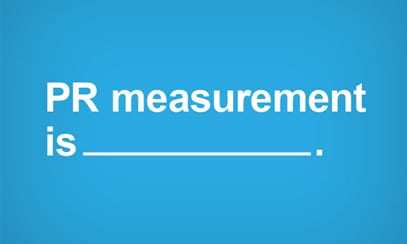 It’s no secret that we live in a time of great disruption, wrought by powerful changes in the relationships among people, process and technology. Very few, if any, aspects of our personal, professional or collective lives have escaped these waves of change, which will combine into a single tsunami that will inevitably reshape everything around it.
It’s no secret that we live in a time of great disruption, wrought by powerful changes in the relationships among people, process and technology. Very few, if any, aspects of our personal, professional or collective lives have escaped these waves of change, which will combine into a single tsunami that will inevitably reshape everything around it.
I’m talking about the wave of changing expectations. Any leader will tell you that there’s no more powerful force in the world.
We’ve seen a lot of this disruptive power in marketing and communications, and we’re about to see a lot more. Social and mobile have combined with cloud-based platforms and nascent Big Data to put more power in the hands of our customers than ever before, all while giving us an enhanced illusion of control. But the rapidly evolving expectations of our stakeholders say otherwise, and they are already shaking the ground under our feet.
Our failure to demonstrate the associations between what we do and business value creation has perpetuated a vacuum of credibility with the C-suite. For years, our protests that “these things couldn’t be measured” were grimly accepted because, in the end, no one knew how to even begin to do it. Today, with the advent of Big Data and business analytics, fewer and fewer CEOs and CFOs are willing to cut our profession any slack.
I’ve been polling CEOs and CFOs on this subject for quite a few years now. In the past two years, I’ve seen a notable increase in frustration and a dramatic change in expectations for marketing and communications, particularly in B2B.
By 2020, the impact of these changing expectations will manifest itself in a new, established relationship between our professional compensation and business value creation, which encompasses business metrics like revenue, margin, cash flow and shareholder value.
This change in expectations is already setting new forces in motion, and the result will be nothing short of Darwinian. Those agencies and individuals who can demonstrate the ability to create that value and prove its presence will rise to a high orbit. Those that cannot adapt will eventually fall to Earth.
I see this manifesting in several ways as we move towards 2020.
- Businesses will use proven approaches to frame “proof of impact.” The analytics involved will be mandated on a top-down basis and will be grounded in accepted business practices. The CFO will become a much more important constituent than we’ve seen previously.

Mark Stouse - The “investment fund” approach to creating value will go mainstream. One example of this trend will be the broad-based use of predictive modeling, which will be critical to delivering impact as well as managing opportunity cost across paid, earned, shared and owned channels. Happily, history reveals a profound upside—top-performing agencies will see unprecedented margin expansion.
- Marketing and communications performance will be independently evaluated. The C-suite and the board will take the initiative to acquire and implement the tools and platforms necessary to establish marketing and communications’ contribution to business value creation.
- Clear value creation will drive agency selection more than size or cost. Once businesses can ascertain the contribution to business value creation, the expense line ceases to be the primary concern, except in situations where absolute affordability is a relevant factor.
- Value-based agency compensation structures will be non-negotiable. Traditional “time and materials” approaches will be increasingly challenged, and businesses will no longer negotiate based on the agency rate card.
- Top-performing individuals will earn a lot more. For years, the max rate that clients would pay for different levels of agency professionals had the effect of holding down individual compensation, not only in the agencies themselves but on the client side as well. The replacement of the traditional rate-driven agency model with a value-based approach will unlock individual compensation for top performers.
- Professional career satisfaction will improve dramatically. Historically, many companies—particularly in B2B—have resisted the marketing-and communications-led orientation, primarily because of the functions’ inability to demonstrate impact on revenue, margin, cash flow and other areas of business value creation. The determination of the C-suite to resolve this issue will begin to reverse this longstanding pattern. As a result, a marketing and communications career—again, particularly in B2B—will become more and more satisfying, particularly as impact-based compensation also climbs.
There will be other impacts as well—disruptive change always brings with it the laws of unintended consequences and unforeseen results. But the key takeaway is hugely positive. While many old rice bowls may be upended in the next few years, many more new ones will be filled to overflowing. And though they may make the initial leap under duress, the agencies and individuals who “cross the chasm” of C-suite dissatisfaction into the sunlit lands of business value creation will prosper as never before.
Mark Stouse is the managing member of Vaulting Ventures LLC, a consortium of business leaders that supports early-stage companies. Stouse created the Influence Scoring System, which correlates many different data streams to demonstrate business value creation via paid, earned, shared and owned channels.
Join members of PR News’ Measurement Hall of Fame for a Twitter chat about the most important trends in PR measurement on Wednesday, Sept. 17, from 1 to 2 p.m. ET.
